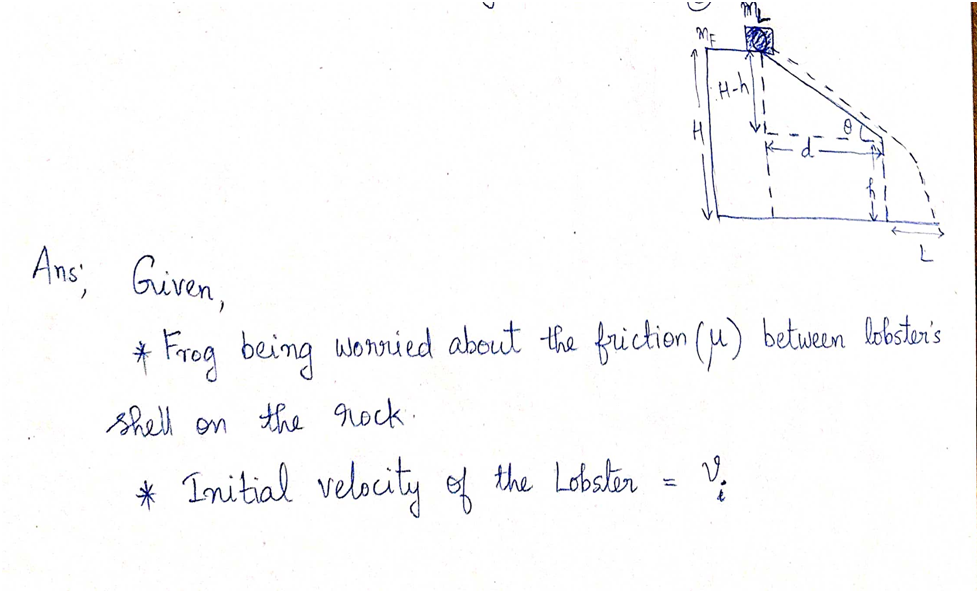2) (Treat as a "forces" problem) Lobster would so much like to experience "flying through the air", as it sees Frog do whenever Frog jumps. So, they devise the following scenario: Slide down a suitable slippery rock, which they indeed find - as shown in the picture below, then "fly" through the air and splash into the ocean. It should work. Frog, being worried about the friction (with coefficient μ) of Lobster's shell on the rock, pushes Lobster to have an initial velocity v₁. (Air resistance is negligible.) H h a) Draw Lobster's free-body diagram while sliding on the rock! b) Draw Lobster's free-body diagram while in free fall! c) How far (distance L) from the rock face does Lobster splash down? d) Only in words: (i) where is Lobster reaching the greatest speed, and why? (ii) were Frog's worries justified? Why/why not? e) Perform a unit check on your result in c.
2) (Treat as a "forces" problem) Lobster would so much like to experience "flying through the air", as it sees Frog do whenever Frog jumps. So, they devise the following scenario: Slide down a suitable slippery rock, which they indeed find - as shown in the picture below, then "fly" through the air and splash into the ocean. It should work. Frog, being worried about the friction (with coefficient μ) of Lobster's shell on the rock, pushes Lobster to have an initial velocity v₁. (Air resistance is negligible.) H h a) Draw Lobster's free-body diagram while sliding on the rock! b) Draw Lobster's free-body diagram while in free fall! c) How far (distance L) from the rock face does Lobster splash down? d) Only in words: (i) where is Lobster reaching the greatest speed, and why? (ii) were Frog's worries justified? Why/why not? e) Perform a unit check on your result in c.
College Physics
11th Edition
ISBN:9781305952300
Author:Raymond A. Serway, Chris Vuille
Publisher:Raymond A. Serway, Chris Vuille
Chapter1: Units, Trigonometry. And Vectors
Section: Chapter Questions
Problem 1CQ: Estimate the order of magnitude of the length, in meters, of each of the following; (a) a mouse, (b)...
Related questions
Topic Video
Question
Hello,
Can someone please show how to solve parts a b and c please?
Thank you

Transcribed Image Text:The image presents a physics problem involving a scenario where a lobster experiences the sensation of "flying through the air" as it sees a frog do. The setup is as follows:
- A lobster slides down a slippery rock surface, represented by an incline, and then travels through the air into the ocean.
- The incline has a height \( H \) and the horizontal distance from the incline to the water's edge is \( L \).
The problem states that:
- The lobster is subjected to friction on the rock with a coefficient of friction \( \mu \).
- The lobster is given an initial velocity \( v_i \) by the frog.
- Air resistance is negligible.
The tasks presented in the problem are:
a) **Draw Lobster’s free-body diagram while sliding on the rock:**
- Illustrate forces such as gravitational force, normal force, frictional force, and any applied force.
b) **Draw Lobster’s free-body diagram while in free fall:**
- Show forces acting on the lobster such as gravitational force.
c) **Calculate distance \( L \):**
- Determine how far from the rock face the lobster splashes down using physics principles.
d) **Determine the position of greatest speed:**
- Explain where the lobster reaches its maximum speed and justify the frog's concerns about friction.
e) **Perform a unit check:**
- Validate the units of the result from part (c) to ensure dimensional consistency.
The diagram includes various dimensions:
- \( H \) represents the height of the rock.
- \( d \) is the horizontal length of the inclined surface.
- \( h \) is the vertical drop to the water's edge from the horizontal.
- \( L \) is the horizontal distance the lobster travels while in the air.
This problem encompasses concepts of physics including forces, motion, and energy considerations.
Expert Solution
Step 1

Step by step
Solved in 5 steps with 5 images

Knowledge Booster
Learn more about
Need a deep-dive on the concept behind this application? Look no further. Learn more about this topic, physics and related others by exploring similar questions and additional content below.Recommended textbooks for you

College Physics
Physics
ISBN:
9781305952300
Author:
Raymond A. Serway, Chris Vuille
Publisher:
Cengage Learning

University Physics (14th Edition)
Physics
ISBN:
9780133969290
Author:
Hugh D. Young, Roger A. Freedman
Publisher:
PEARSON

Introduction To Quantum Mechanics
Physics
ISBN:
9781107189638
Author:
Griffiths, David J., Schroeter, Darrell F.
Publisher:
Cambridge University Press

College Physics
Physics
ISBN:
9781305952300
Author:
Raymond A. Serway, Chris Vuille
Publisher:
Cengage Learning

University Physics (14th Edition)
Physics
ISBN:
9780133969290
Author:
Hugh D. Young, Roger A. Freedman
Publisher:
PEARSON

Introduction To Quantum Mechanics
Physics
ISBN:
9781107189638
Author:
Griffiths, David J., Schroeter, Darrell F.
Publisher:
Cambridge University Press

Physics for Scientists and Engineers
Physics
ISBN:
9781337553278
Author:
Raymond A. Serway, John W. Jewett
Publisher:
Cengage Learning

Lecture- Tutorials for Introductory Astronomy
Physics
ISBN:
9780321820464
Author:
Edward E. Prather, Tim P. Slater, Jeff P. Adams, Gina Brissenden
Publisher:
Addison-Wesley

College Physics: A Strategic Approach (4th Editio…
Physics
ISBN:
9780134609034
Author:
Randall D. Knight (Professor Emeritus), Brian Jones, Stuart Field
Publisher:
PEARSON